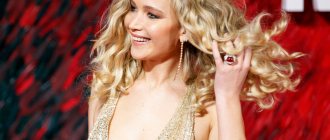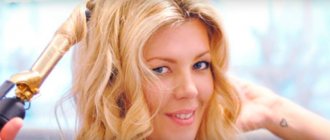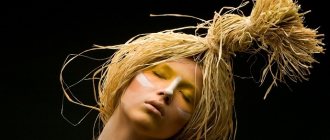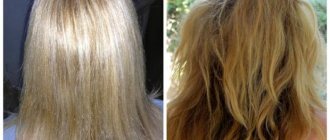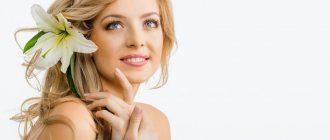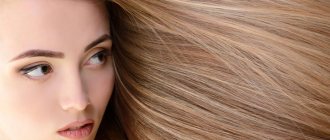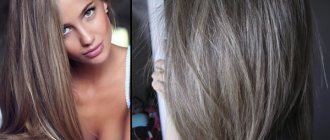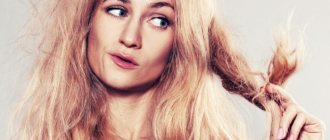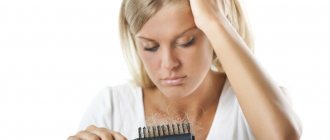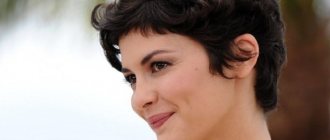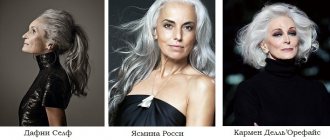Head massage
This procedure is very useful for all hair types, except those that are too oily. In this case, the secret of beautiful hair is that during the massage, blood circulation is stimulated, which helps nourish the scalp and the hair itself with oxygen. You can do a head massage yourself using circular and vibrating movements for 10-15 minutes, 1-2 times a week. It is best to do this before washing and immediately during it. The effectiveness of the massage will increase significantly if you use another secret to beautiful hair - use castor or burdock oil or herbal decoctions during the procedure.
Our entire body requires proper nutrition and careful care, and hair is no exception. Therefore, use the secrets of beautiful hair and always be on top.
Hair shine mask
To prepare a mask that adds shine to your hair, you will need to prepare the following ingredients:
- castor oil 1 tsp;
- glycerin 1 tsp;
- vinegar 1 tsp;
- egg 2 pcs.
How to properly prepare a mask:
- First, beat the eggs until smooth, but not foamy.
- Then add oil and glycerin to them and mix.
- The final step is to add vinegar and mix again.
- Apply to pre-washed hair and leave for twenty to thirty minutes.
- Wash off the mask after time with shampoo.
- After washing, use conditioner for extra moisture.
ELECTRONIC LIBRARY ModernLib.Net
Basic knowledge about hair
Hair is an integral part of a woman's appearance. The covering of the head that they form protects against exposure to the atmosphere, heat, and cold. Hair regulates the body's temperature because it is connected to nerve endings as well as muscles.
Hair –
This is a cylindrical thread that is an extension of the human scalp. Inside it consists of a root, and outside – from a trunk.
There are approximately 100 to 150 thousand hairs on the head. Their distribution density is from 250 to 300 per square centimeter.
Hair can grow at a rate of 1 to 1.5 cm per month.
On average, each hair lives from 4 to 6 years.
We lose from 40 to 100 hairs per day. This is a normal number.
The composition of hair includes: 70-80% proteins, 10-15 - water, 3-6 - lipids, 0.1-0.5 - carbohydrates, 0.06-0.05 - minerals and about 1% melanin.
Hair ( Fig. 1
) is a multistructural organism that has roots, rods, skin, epidermis, dermis, hypodermis, hair follicle, bulbs, hair papillae, hair muscles, sebaceous and sweat glands, blood vessels.
There are three types of hair:
• long
(hair of the head, beard, mustache, armpits, pubis);
• bristly
(hair of eyebrows, eyelashes, ear canal, sinus);
• cannon
(other areas of the skin).
All of them are epithelial appendages of the skin.
Hair root
(1) is located in the dermis, in the hair follicle, and is located at a certain angle,
the shaft
is on the surface (2),
the skin
is hidden under the hair (3).
Thanks to the skin, protection from the aggressive effects of the external environment occurs. Through it, toxins are eliminated and sweat is released. The skin has several layers: the cuticle, or epidermis
(4), the skin itself, or
dermis
(5), and subcutaneous fatty tissue, or
hypodermis (6).
Rice. 1. Hair structure
The epidermis consists of an incredible number of cells, but its thickness is only a few tenths of a millimeter. The main layer of the epidermis is living and full-fledged cells.
Old cells, having separated from the main layer, form, in turn, a dense stratum corneum. It protects living cells of the main layer from mechanical damage, prevents the passage of water with chemicals dissolved in it, and traps ultraviolet rays and microbes.
The second layer of skin is the dermis. It is filled with nerve endings, elastic strong fibers, blood vessels, sebaceous and sweat glands, hair follicles, and muscles. Thanks to it, optimal body temperature is maintained. In this layer, the thickened base of the hair root, the bulb, develops.
The hypodermis is a heterogeneous subcutaneous tissue of a cellular shape, its thickness depends on the area of the body that it covers.
Thanks to the hypodermis, a person’s thermal insulation is ensured and the effects of inevitable mechanical factors are leveled out. This is where the base of the bulb is located.
hair follicle,
or
hair follicle
(7), is the property of every hair. The hair follicle contains the root part of the hair, the one that is oval in shape. The follicle is located in the dermis and is a tubular depression. Each follicle contains seven different types of cells that interact with nerve and blood cells.
The hair ends in a thickening called the hair follicle
(8). It forms new hair, providing it with growth due to its epithelial cells, which move into the medulla and cortex of the hair root, its cuticle and into the internal epithelial sheath. It looks like an elongated drop in the lower, expanded part of the hair root. The hair always falls out along with the hair follicle.
The hair follicle contains the connective pilar papilla
(9). It camouflages itself at the bottom of the follicle, a sort of small conical-shaped elevation protruding into the bulb. Vessels and nerve endings approach it. Its role in the process of hair growth is the main one. If you pull out a hair but leave the papilla, new hair will grow from it. Above the papilla is the germ part, or matrix. There the cells divide, grow and form the hair itself.
At the border of the epidermis, the follicle connects to the hair muscle
(10) - a tiny “mechanism” that, figuratively speaking, makes your hair stand on end. Our fear provokes its contraction. The hair rises and straightens. The same thing happens when we freeze. In other words, the hair muscle has the unique ability to contract as a result of emotions.
Sebaceous glands
(11) - pouch-shaped protuberances that direct their ducts into the hair follicle. Elasticity and shine of hair are acquired thanks to the secretion secreted by lard. Violation of its production leads either to dry skin, or, conversely, to excessive oiliness, seborrhea. When we wash our hair, we destroy the water-lipid film that prevents the epidermis from drying out.
Sweat glands are peculiar “balls” that go to the pores, i.e., external openings. If we consider each of them, it resembles a tube or channel and is placed in a base located in the dermis. Vessels
(12) nourish the hair papilla with blood.
The hair shaft is located above the surface of the skin. It can be straight or at an angle. The rod consists of thread-like structures covered with layers of transparent keratin scales. The hair core is soft and spongy. Water and a number of substances penetrate through it.
Hair shaft (Fig. 2a)
divided into
cuticle
(1),
cortex
(2) and
medulla
(3).
For clarity, let us present the structure of hair in different diagrams (Fig. 2b).
1 – cuticle;
2 – cortex;
3 – medulla
1 – cortex; 2 – medulla; 3 – hair cuticle; 4 – cuticle of the root sheath; 5 – internal root sheath; 6 – external root sheath; 7 – matrix; 8 – papilla of the hair follicle; 9 – melanocyte; 10 – haline membrane; 11 – connective tissue; 12 – blood vessels
Rice. 2. Structure of the hair shaft
The outer layer of hair - the cuticle - is made up of dead keratin cells. These cells in the form of flat scales are located, covering one another, like fish scales. The opening part of the scales is directed towards the end of the hair. The scales can move away from the surface - open, spread out when exposed to alkali, or press against the surface, close when exposed to an acidic environment. At the same time, the hair becomes dense and shiny. The cuticle is a transparent, non-porous layer that does not absorb moisture. It expands with heat and contracts with cold. It is the main protection of the hair.
The cortex, or cortical substance, is a fibrous layer. It consists of proteins and lipids. Fills 80% of the hair volume and gives it strength and elasticity. The keratin fibers that form it are interconnected by “bridges”, but have microscopic air cavities. The fibers are cross-linked and the strength of the hair depends on them. The cells contain the pigment melanin. All chemical and physical processes take place in this layer during coloring and perm. Melanin is insoluble in water, but reacts with alkalis and acids.
Medulla, or medulla, the pulpy layer is a channel inside the hair shaft. It consists of incompletely keratinized flattened round cells without a certain cohesion. Contains fat granules and air inclusions.
Not all types of hair have a medulla, and this is not a pathology. It does not play a significant role in the chemical and physical properties of hair.
Between the cuticle scales, between the cuticle and the cortex, there is a lipid layer that ensures a tight fit of the scales to each other. This protects hair from aggressive external influences.
Healthy hair has closed scales and an even, smooth, shiny shaft.
When the lipid layer is destroyed, mechanical stress leads to fragility of the scales.
Hair is born, lives and dies. Three main phases of its life cycle can be distinguished (Fig. 3): anagenesis
(1),
catagenesis
(2),
telogenesis
(3).
When hair is born, the hair papilla receives nutrition through blood vessels and produces cells. The resting state of the papilla lasts 28 days. Hair begins to form within 2-3 months.
Rice. 3. Growth phases
Next comes the phase of active growth - anagenesis. The cells located in the hair follicle are actively dividing and moving upward, towards the follicular opening. Melanocytes intensively synthesize melanin, which colors the keratin of the hair. The duration of the phase can last from 3 to 6 years. 85% of hair is in this phase, when the hair is thin and without a body.
The next transitional phase is of regressive changes. This is catagenesis. The activity of the matrix fades away, cell division stops. Melanocytes finish producing melanin. The hair follicle atrophies, the hair is separated from the matrix. Destruction of the bulb and shortening of the follicle are observed. This phase most often lasts 2-4 weeks. It contains 1% of hair.
The final phase is telogenesis. This is the resting phase. Hair growth stops and keratinization is completed. The hair follicle becomes permanently shortened. The dead hair shaft is removed and the bulb completely atrophies.
When the hair follicle becomes active again, the old hair is replaced by new hair and falls out. The duration of the phase is 3-6 months. It contains 14% of hair.
The process of natural hair replacement is imperceptible. The growth and resting phases of adjacent follicles do not coincide.
Genetically, during a person's life, about 25 complete hair growth cycles are programmed.
Hair in its mass consists of proteins such as carotene.
It is a fibrous protein made up of amino acids. Carotene also contains water and fats. It performs a structure-forming function and ensures the desired consistency of each hair.
The most important amino acids that form protein are histidine, isoleucine, leucine, lysine, methionine, phenylalanine, threonine, tryptophan, valine.
By eating right, a person provides his hair with excellent condition. The daily diet should include vitamins, proteins, minerals, and sugars.
Vitamin E contained in olive, corn, sunflower, and sunflower oils is well absorbed. These oils are rich in fatty acids that have a beneficial effect on hair growth .
There is a lot of vitamin E in broccoli and Brussels sprouts. cabbage, green vegetables, spinach, vegetable oil, beans and wheat germ.
Natural hair color depends on the pigment melanin.
It contains a dye and is produced by melanocytes in the hair follicle.
It can be black - eumelanin,
brown -
phacomelanin
and yellow -
pheomelanin
. Hair color depends on the amount of melanin in its cortex.
Melanin granules are distributed in the sheath, root and shaft of the hair. The closer the melanin is to the outer layer of the hair, the less coloring substances there are. There are almost no these substances in the cuticle.
Dark hair contains more pigment than light hair.
If the melanin granules are elongated, a dark color is formed; the round or oval shape of the granules provides a red color; the combination of elongated and oval granules gives a reddish-brown tint, and elongated and a small number of round granules give a black with a reddish tint.
Scattered pigments nourish the cell evenly, saturating it with colors from red to yellow. Each person has their own combination of natural pigments and individual hair shade. Hair color is determined by genes, i.e. a biological, hereditary factor.
Melanin comes in two states: granular and diffuse.
Granular melanin stands out against the scattered background. It looks like small granules and colors hair from reddish-brown to black. Scattered pigment gives the hair yellow-red tones.
Natural color is always the result of mixing.
The amount of pigments in natural hair color
Pigments predominant in natural hair
Years pass, melanin production decreases, hair becomes dull and gray.
Each hair has elasticity, plasticity, strength, electrical conductivity, density, hygroscopicity, porosity.
It has its own
texture, shape, length.
Healthy hair can be stretched by 10%. Elastic hair is capable of stretching and returning to its original length. When chemically treated, such as bleaching or permanentizing, they can stretch up to 40%. The strength and elasticity of your hair can be doubled by soaking it in cold water. They can be easily reduced using hot water.
The plasticity of hair allows you to change its natural shape to an arbitrary one, achieved with the help of hairdressing tools.
Vitamin A is found in carrots, spinach, sorrel, sea buckthorn and dairy products. When eating carrots, season them with vegetable oil or sour cream so that vitamin A is well absorbed. Drink a glass of freshly squeezed carrot juice daily.
Healthy hair of a young body can withstand weight up to 230 g.
Dry hair is a conductor of electricity. They are easily electrified when combed with a metal or plastic brush, receiving a negative charge.
Hair density is an individual factor. The hair of brown-haired and brunettes can contain 100,000-150,000 fibers. Brown hair has 140,000 fibers.
Hair absorbs moisture. The cuticle rises in the direction opposite to the hair shaft to provide moderate hygroscopicity. Hair absorbs water, steam, and fats well. When exposed to moisture, hair can change shape. This is observed when curling hair in curlers, i.e. during cold styling.
Hair porosity can be low, normal or excessive. It depends on the level of formation of pores - voids in the hair shaft. Porosity increases with coloring and bleaching, as well as after exposure to ultraviolet radiation.
Hair texture is determined by thickness and stiffness. Hair can be thin, normal, thick, soft, hard, glassy. It depends on the difference in hair diameter. It's easy to tell by touch whether your hair is soft or coarse.
Hair shape is divided into straight and wavy
and
curly.
Straight hair is a tubular process of round cross-section, wavy hair is oval, curly hair is flat.
Hair length is measured from root to tip.
Hair varies by type: normal, oily, dry, combination.
B vitamins are found in eggs. yolk, yeast, brown rice, green leafy vegetables.
Vitamin B1 is found in peanuts, dry yeast, vegetables, and milk. Vitamin B2 is found in cheese, dairy products, vegetables, fish, and liver.
Hair conditioners and balms
Modern conditioners are very helpful in keeping hair healthy, moisturizing and strengthening it. Using these products will make your hair shiny, give it volume, prevent the formation of static tension during combing and protect your hair when styling with a hairdryer.
Hair balms are even more effective because they can restore damaged hair structure and provide hair follicles with nutrients. Today, there is almost no difference between balms and conditioners - both have similar effects, have a creamy consistency and are equally effectively used to strengthen depleted and weakened hair.
